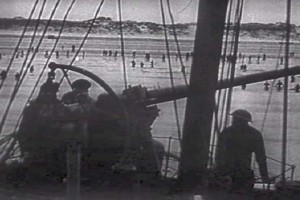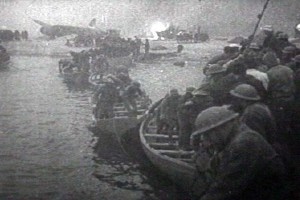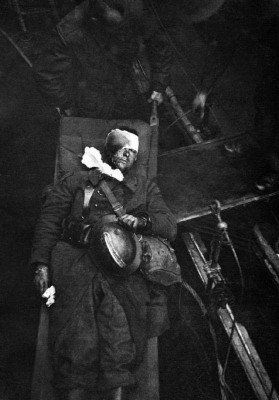 In World War II, the Dunkirk evacuation, code named Operation Dynamo, refers to the evacuation of thousands of Allied troops from northern France in the late spring of 1940. It occurred after French, British, and Belgian soldiers had been pushed back to the coast by the German advance. Winston Churchill, the Prime Minister of the United Kingdom, emphasized that the evacuation should not be seen as a military victory. Nevertheless, the almost miraculous saving of hundreds of thousands of men who had seemed doomed to capture by the advancing Germans came to be seen as emblematic of British refusal to admit defeat.
In World War II, the Dunkirk evacuation, code named Operation Dynamo, refers to the evacuation of thousands of Allied troops from northern France in the late spring of 1940. It occurred after French, British, and Belgian soldiers had been pushed back to the coast by the German advance. Winston Churchill, the Prime Minister of the United Kingdom, emphasized that the evacuation should not be seen as a military victory. Nevertheless, the almost miraculous saving of hundreds of thousands of men who had seemed doomed to capture by the advancing Germans came to be seen as emblematic of British refusal to admit defeat.
Background
German troops marched into Belgium, the Netherlands, and Luxembourg in the early hours of May 10, 1940. Responding to the invasion, units of the British Expeditionary Force and sections of the French army came to give aid, but the Low Countries were quickly occupied by the Nazis. Four days later, German tanks rapidly advanced across the Ardennes and began a powerful push northward toward the English Channel.
The BEF and the French army proved unable to resist this push effectively. Once the Germans had reached the northern coast, the BEF troops were cut off from aid, as were a considerable number of other Allied soldiers in the area. The Germans then mounted an all-out offensive to capture the northern coastal ports and capture or kill the Allied soldiers who were trapped there. Hitler realized that doing this would be both a military and a propaganda victory, and could have a devastating effect on British morale.
On May 24, Adolf Hitler traveled to the town of Charleville, where Army Group A of the Wehrmacht had its headquarters. Hitler impressed on General von Rundstedt, who commanded the group, the importance of a quick attack. After surveying the situation for himself, von Rundstedt suggested that his armor would hold station to the southwest of Dunkirk. Meanwhile, Army Group B’s infantry, supported by overhead cover from the air force, would deal with the BEF.
The Evacuation Takes Shape
 On May 25, General Lord Gort, who was in command of the BEF, decided that the deterioration of his position had made it imperative that he attempt to evacuate his soldiers from France. His troops, backed by Belgian and French forces, set up a perimeter defense around Dunkirk, one of the most significant of the Channel ports. The port was considered the best chance of getting the largest possible number of men back to England.
On May 25, General Lord Gort, who was in command of the BEF, decided that the deterioration of his position had made it imperative that he attempt to evacuate his soldiers from France. His troops, backed by Belgian and French forces, set up a perimeter defense around Dunkirk, one of the most significant of the Channel ports. The port was considered the best chance of getting the largest possible number of men back to England.
Meanwhile, back in Britain, Churchill met with Vice Admiral Ramsay to plan the evacuation. Their meeting, which was held at Dover Castle, resolved that the Allied servicemen would be evacuated by both naval destroyers and large merchant ships. However, these would be supplemented by the so-called “little ships”, numbering more than 700, which ranged from small commercial boats from pleasure crafts to fishing trawlers.
The British fully expected that they would have a maximum of 48 hours to mount the evacuation, and after that the Germans would prevent the operation from continuing. As such, they planned for around 45,000 soldiers to be brought away from Dunkirk. As the rescue fleet reached the port, the Allied troops, abandoning heavy equipment in order to save space and time, prepared for the voyage. Some of the men had no choice but to wade into the sea to reach the waiting boats, although others managed to use the harbor mole to board directly.
Commencement
Operation Dynamo commenced on May 27, and on that day around 7,600 men were rescued from Dunkirk. The following day proved more productive, with close to 18,000 men being brought away. Despite strong support from the Royal Air Force in keeping Luftwaffe planes away from the embarkation points, the port’s perimeter defense gradually began to be squeezed inward. Nevertheless, the evacuations continued. May 29 saw more than 47,000 troops brought to safety, while the last two days of the month accounted for another 121,000 men.
The Germans were desperate to stop the evacuations, and mounted a heavy air attack late in the day on the 29th. By the end of the month, the Allied-held pocket around Dunkirk had been reduced to a strip measuring a mere three miles across. Even so, a further 64,000 soldiers were rescued on June 1. Luftwaffe operations intensified, and it became impossibly dangerous for the ships of the evacuation fleet to carry out their mission in the daytime.
Night-time rescues continued at speed, however, with well over 50,000 Allied soldiers being evacuated from what remained of the Dunkirk pocket until the early hours of June 4. By now, the German front line was almost within sight of Dunkirk harbor, and the decision was made to call off the evacuations after the Royal Navy ship HMS Shikari had departed a little before four o’clock in the morning of June 4. Two French divisions remained behind in order to try to defend the ever-shrinking perimeter. Although they resisted gallantly, they eventually had no choice but to surrender to the Germans.
Aftermath and Legacy
 Rather than the modest 45,000 men originally expected to be rescued, Operation Dynamo in fact saved more than 330,000 Allied troops from certain death or capture at German hands. In Britain especially, popular sentiment was thrilled by the success of the rescue mission, and the “gallant little ships” that had assisted in the evacuation drew particular praise, it being felt that they represented the true fighting spirit of the United Kingdom and its refusal to give in to the Nazi menace.
Rather than the modest 45,000 men originally expected to be rescued, Operation Dynamo in fact saved more than 330,000 Allied troops from certain death or capture at German hands. In Britain especially, popular sentiment was thrilled by the success of the rescue mission, and the “gallant little ships” that had assisted in the evacuation drew particular praise, it being felt that they represented the true fighting spirit of the United Kingdom and its refusal to give in to the Nazi menace.
Churchill himself was more circumspect; “Wars,” he said, “are not won by evacuations” and he warned against turning what in fact was a last-ditch rescue after a crushing defeat into a great victory. Operation Dynamo was a costly operation for the British: more than 68,000 men were killed, wounded, or captured, while over 240 ships and more than 100 aircraft were lost. The requirement for a speedy evacuation had also mean that half a million tons of supplies had to be left on the French side of the Channel. Crucially, however, the success of the evacuation meant that a strong defensive force would now be available for the anticipated invasion of England itself.